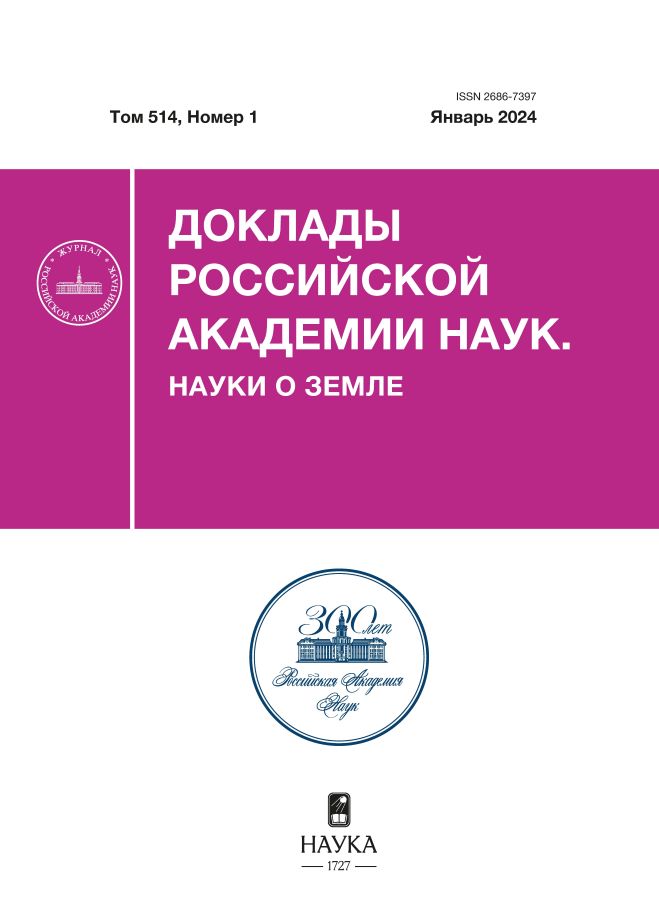On the connection of the Early Cambrian basins of Western Mongolia and Southern France on malacological data
- 作者: Parkhaev P.Y.1, Zhegallo E.A.1, Dorjnamjaa D.2
-
隶属关系:
- Borisyak Paleontological Institute, Russian Academy of Sciences
- Paleontological Institute, Mongolian Academy of Sciences
- 期: 卷 514, 编号 1 (2024)
- 页面: 122-130
- 栏目: PALEONTOLOGY
- ##submission.dateSubmitted##: 31.01.2025
- ##submission.datePublished##: 27.06.2024
- URL: https://rjmseer.com/2686-7397/article/view/650029
- DOI: https://doi.org/10.31857/S2686739724010148
- ID: 650029
如何引用文章
详细
The study of previously collected fossils and new materials on Cambrian mollusks from the Bayangol Formation of Western Mongolia (Zavkhan structural-facies zone) revealed a significant similarity in the taxonomic composition of the mollusk assemblages of Western Mongolia and Southern France (Heraultia Limestone, Marcou Formation, Montagne Noire). In addition to the previously reported four common species (Latouchella korobkovi (Vostokova, 1962), Protoconus orolgainicus (Zhegallo, 1996), Purella tenuis Zhegallo, 1996, and Watsonella crosbyi Grabau, 1900), we have identified 10 more common species for these regions: Auricullina auriculata (Vassiljeva, 1990), Bemella jacutica (Missarzhevsky, 1966), “Calbyella” multicostata Missarzhevsky, 1995, Cambroscutum concameratum Kerber, 1988, Helcionella sp., Merismoconcha tommotica (Zhegallo, 1996), Obtusoconus amplus (Zhegallo, 1982), Prosinuites tripartitus Kerber, 1988, Purella layracensis (Kerber, 1988), and Securiconus sp. We have to reconsider the existing reconstruction of faunal relations of paleobasins on the western frame of Gondwana in terms of substantiating a close faunal exchange with the Zavkhan terrane, which during the Early Cambrian was a part of microcontinents chain located at low latitudes between the Siberian Platform in the west and Gondwana in the east.
全文:
作者简介
P. Parkhaev
Borisyak Paleontological Institute, Russian Academy of Sciences
编辑信件的主要联系方式.
Email: pparkh@paleo.ru
俄罗斯联邦, Moscow
E. Zhegallo
Borisyak Paleontological Institute, Russian Academy of Sciences
Email: pparkh@paleo.ru
俄罗斯联邦, Moscow
D. Dorjnamjaa
Paleontological Institute, Mongolian Academy of Sciences
Email: pparkh@paleo.ru
蒙古, Ulan-Bator
参考
- Peng S. C., Babcock L. E., Ahlberg P. Chapter 19. The Cambrian Period / Geologic Time Scale 2020. Gradstein F. M., Ogg J. G., Schmitz M. D., Ogg G. M. (eds.). Amsterdam: Elsevier, 2020. P. 565–629.
- Torsvik T. H., Cocks L. R.M. New global palaeogeographical reconstructions for the Early Palaeozoic and their generation / Early Palaeozoic Biogeography and Palaeogeography. Harper D. A.T., Servais T. (eds.). L.: Geological Society, 2013. P. 5–24 (Memoirs of Geological Society of London. V. 38).
- Bold U., Crowley J. L., Smith E. F., Sambuu O., Macdonald F. A. Neoproterozoic to Early Paleozoic tectonic evolution of the Zavkhan terrane of Mongolia: Implications for continental growth in the Central Asian orogenic belt // GSA Lithosphere. 2016. V. 8. № 6. P. 729–750.
- Есакова Н. В., Жегалло Е. А. Фауна и биостратиграфия нижнего кембрия Монголии. М.: Наука, 1996. 216 с. (Тр. Совм. Рос.-Монгол. палеонтол. экспед. Вып. 46).
- Воронин Ю. И., Воронова Л. Г., Григорьева Н. В., Дроздова Н. А., Жегалло Е. А., Журавлев А. Ю., Рагозина А. Л., Розанов А. Ю., Саютина Т. А., Сысоев В. А., Фонин В. Д. Граница докембрия и кембрия в геосинклинальных областях. М.: Наука, 1982. С. 1–152. (Тр. Совм. Сов.-Монгол. палеонтол. экспед. Вып. 18).
- Миссаржевский В. В. Раннекембрийские хиолиты и гастроподы Монголии // Палеонтологический журнал. 1981. № 1. С. 21–28.
- Cobbold E. S. Lower Cambrian faunas from Hérault, France // Annals and Magazine of Natural History. Ser. 10. 1935. V. 16. P. 25–49.
- Kerber M. Mikrofossilien aus unterkambrischen Gesteinen der Montagne Noire, Frankreich // Palaeontographica. 1988. Abt. A. V. 202. P. 127–203.
- Devaere L., Clausen S., Steiner M., Álvaro J., Vachard D. Chronostratigraphic and palaeogeographic significance of an Early Cambrian microfauna from the Heraultia Limestone, northern Montagne Noire, France // Palaeontologia Electronica. 2013. V. 16. Iss. 2. № 17A. P. 1–91.
- Parkhaev P. Yu., Demidenko Yu. E. Zooproblematica and Mollusca from the Lower Cambrian Meishucun Section (Yunnan, China), and Taxonomy and Systematics of the Cambrian Small Shelly Fossils of China // Paleontological Journal. 2010. V. 44. № 8. P. 883–1161.
- Landing E. Paleoecology and distribution of the Early Cambrian rostroconch Watsonella crosbyi Grabau // Journal of Paleontology. 1989. V. 63. № 5. P. 566–573.
- Parkhaev P. Yu. Molluscs and siphonoconchs / The Cambrian Biostratigraphy of the Stansbury Basin, South Australia. Alexander E. M., Jago J. B., Rozanov A. Yu. Zhuravlev A. Yu. (еds.). Moscow: MAIK Nauka / Interperiodica, 2001. P. 133–210.
- Пархаев П. Ю. Кембрийские моллюски Австралии: обзор таксономии, биостратиграфии и палеобиогеографии // Стратиграфия. Геологическая корреляция. 2019. Т. 27. № 2. С. 52–78.
- Guo J.-F., Li G.-X., Qiang Y.-Q., Son Z.-C., Zh. Zh.-F., Han J., Wang W.-Z. Watsonella crosbyi from the lower Cambrian (Terreneuvian, Stage 2) Yanjiahe Formation in Three Gorges Area, South China // Palaeoworld. 2021. V. 30. P. 1–19.
- Васильева Н. И. Мелкая раковинная фауна и биостратиграфия нижнего кембрия Сибирской платформы. СПб.: ВНИГРИ, 1998. 139 с.
- Розанов А. Ю., Пархаев П. Ю., Демиденко Ю. Е., Карлова Г. А., Иванцов А. Ю., Коровников И. В., Шабанов Ю. Я., Лучинина В. А., Малаховская Я. Е., Мельникова Л. М., Наймарк Е. Б., Пономаренко А. Г., Раевская Е. Г., Скорлотова Н. А., Сундуков В. М., Токарев Д. А., Ушатинская Г. Т., Киприянова Л. Д. Ископаемые из стратотипов ярусов нижнего кембрия. М.: ПИН РАН, 2010. 228 с.
- Розанов А. Ю., Миссаржевский В. В. Биостратиграфия и фауна нижних горизонтов кембрия. М.: Наука, 1966. 127 с. (Тр. Геол. ин-та АН СССР. Вып. 148).
- Миссаржевский В. В. Новые окаменелости из древнейших отложений кембрия Сибирской платформы // ДАН. 1995. Т. 344. № 5. С. 665–668.
- Миссаржевский В. В. Древнейшие скелетные окаменелости и стратиграфия пограничных толщ докембрия и кембрия. М.: Наука, 1989. 238 с. (Тр. Геол. ин-та АН СССР. Вып. 443).
- Yu W. Yangtze micromolluscan fauna in Yangtze region of China with notes on the Precambrian-Cambrian boundary // Stratigraphy and palaeontology of systemic boundaries in China. Precambrian-Cambrian boundary. 1987. V. 1. P. 19–344.
补充文件











